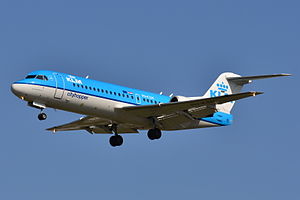Fokker 70
| Fokker 70 | |
|---|---|
 |
|
| KLM Cityhopper Fokker 70 | |
| Role | Airliner |
| National origin | Netherlands |
| Manufacturer | Fokker |
| First flight | 4 April 1993 |
| Introduction | October 1994 with Ford Motor Company (private) 1995 with Sempati Air (commercial) |
| Status | Out of production, in service |
| Primary users |
KLM Cityhopper Austrian Airlines Alliance Airlines |
| Produced | 1992-1997 |
| Number built | 47 (+1 prototype) |
| Developed from | Fokker 100 |
The Fokker 70 is a narrow-body, twin-engined, medium-range, turbofan regional airliner produced by Fokker as a smaller version of the Fokker 100. Both the F70 and F100 were preceded by the first jet airliner manufactured by Fokker, the Fokker F28 Fellowship. Since its first flight in 1993, 47 aircraft, plus one prototype, have been manufactured and 38 are still in active service with airlines around the world.
The Fokker company of the Netherlands started to develop the airliner in November 1992 with an aim to replace its aging Fokker F28 airliner, with a more modern and fuel efficient aircraft. The Fokker 70's first flight occurred on 4 April 1993, at the company's base at Woensdrecht in southern Netherlands, and had a duration of three hours. Following its first flight, the Fokker 70 was flown to Granada and Spain, where many hours were logged in order to obtain the certification at the end of 1994. The first production aircraft first flew in July 1994. Certification was granted on 14 October 1994, while the first delivery of a Fokker 70 to a customer, Ford Motor Company (in an "Executive Jet" configuration), occurred later in the same month. The launch customer of this aircraft by an airline was the now-defunct Indonesian airline, Sempati Air.
The development of the Fokker 70 was based on the requirements of some airlines, for which the Fokker 50 or ATR 42 were too small and the Boeing 737 or MD-80 too large. The development consisted in cutting various sections of the fuselage of the Fokker 100, removing 4.62 metres (15.2 ft) of the plane's total length but keeping the wings and tail. With these specifications, total capacity is 80 passengers, 70 in the U.S., due more to meet "scope clause" requirements than any Federal Aviation Administration (FAA) certification.
...
Wikipedia
